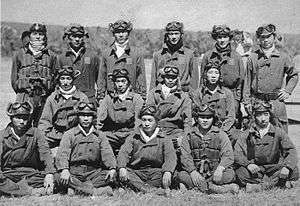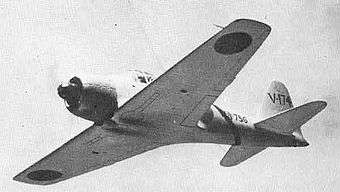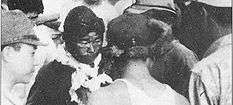Tainan Air Group
The Tainan Air Group (台南海軍航空隊, Tainan Kaigun Kōkūtai) was a fighter aircraft and airbase garrison unit of the Imperial Japanese Navy (IJN) during the Pacific campaign of World War II. The flying portion of the unit was heavily involved in many of the major campaigns and battles of the first year of the war. The exploits of the unit were widely publicized in the Japanese media at the time, at least in part because the unit spawned more aces than any other fighter unit in the IJN.[1] Several of the unit's aces were among the IJN's top scorers, and included Hiroyoshi Nishizawa, Saburō Sakai, Junichi Sasai, Watari Handa, Masaaki Shimakawa, and Toshio Ōta.
| Tainan Air Group | |
|---|---|
 Enlisted fighter pilots of the Tainan Air Group pose at Lae in June 1942. Several of these aviators would be among the top Japanese aces, including Saburō Sakai (middle row, second from left), and Hiroyoshi Nishizawa (standing, first on left). | |
| Active | October 1, 1941 – November 1, 1942 |
| Country | |
| Allegiance | Empire of Japan |
| Branch | |
| Type | Naval aviation unit |
| Role | Air superiority Fighter aircraft support |
| Size | 45-65 aircraft |
| Part of | 25th Air Flotilla, 11th Air Fleet |
| Garrison/HQ | Tainan, Taiwan Legaspi, Philippines Balikpapan, Borneo Denpasar, Bali Rabaul, New Britain Lae, Papua New Guinea |
| Aircraft flown | A6M Zero A5M Claude |
| Engagements | World War II
|

History
Philippines and Dutch East Indies
The unit was formed at Tainan, Taiwan (then part of the Empire of Japan) on October 1, 1941 as part of the 23rd Air Flotilla. The unit's first commander was Lieutenant Hideki Shingō. Most of the unit's original pilots were veterans of aerial combat in the Second Sino-Japanese War. Just before the outbreak of war with the Allied powers, the unit consisted of 45 A6M Zero and 12 Type 96 fighter aircraft.[1][2]
On 8 December 1941 forty-four Tainan aircraft escorted IJN bombers in attacks on US aircraft at Iba and Clark airfields on Luzon in the Philippines, a distance of 500 miles each way. The attacks almost completely destroyed General Douglas MacArthur's air forces. On 10 December Tainan Zeros shot down the B-17 bomber piloted by Colin Kelly. Later that month, the unit redeployed to the Philippines and continued to support Japanese forces as they overran and destroyed the territory's American and Filipino defenses.[3][4][5]
The Tainan Naval Air Group then moved to Tarakan Island, followed by moves to Balikpapan and Denpasar, Bali to support the successful Japanese offensive into the Dutch East Indies beginning in January 1942. The unit's fighters helped inflict heavy losses on defending Allied aircraft in January and February 1942.[6]
New Guinea
With the end of the campaign in March, the unit was integrated into the 25th Air Flotilla and redeployed to recently captured Rabaul, New Britain and Lae, Papua New Guinea in April. As of 25 April 1942, due to operational and combat losses, the Tainan Air Group, now under the command of Captain Masahisa Saitō, counted 26 Zero and six Type 96 "Claude" fighters.[7][8][9][10]
The unit initially concentrated its aircraft at Lae to support an air campaign against the Australian and American forces stationed at Port Moresby. Between April and July, the Tainan Air Group flew 51 missions, totalling 602 sorties. During this time, the unit claimed to have destroyed 300 enemy aircraft. The Tainan's losses were 20 aircraft. Replacement aircraft gave the unit a total of 24 Zeros by August 1942, flown by 55 pilots. Because of the surplus in aircrew, only the most experienced pilots were allowed to fly combat missions.[11][12][13]
Guadalcanal


On August 7, United States Marines landed on Japanese-occupied Guadalcanal, initiating the Guadalcanal Campaign. In response that same day, 18 Tainan fighters escorted bombers from Rabaul for an attack on the Allied invasion fleet, the longest fighter mission of the war (556 miles each way) to that date. The Tainan claimed to have destroyed 43 enemy aircraft over Guadalcanal on that mission while losing two fighters with their pilots themselves. The Americans actually lost 10 aircraft, including nine of 18 fighters present, plus one dive bomber.[14][15] The two Tainan pilots killed on this mission were Petty Officer First Class Yoshida and Petty Officer Second Class Nishiura[16]
One significant Tainan casualty over Guadalcanal that day was Saburō Sakai, who was seriously injured and forced into a two-year recuperation. The US Marines on August 8 captured an airfield (later called Henderson Field) under construction by the Japanese on Guadalcanal which was soon operational with Allied aircraft.[17]
Over the next several months, Tainan aircraft based at Rabaul engaged in repeated dogfights with Allied aircraft, called the Cactus Air Force, based on Guadalcanal. The extreme distances required for the Tainan pilots to fly from Rabaul to Guadalcanal severely hampered the unit's attempts to establish air superiority over the island. The unit also continued to support bombing missions against Port Moresby. Between August and November 1942, the Tainan lost 32 pilots killed in action.[17] Junichi Sasai was killed on August 26 and Toshio Ōta on October 21.[18]
On November 1, 1942 the Japanese naval units in the Southeast Pacific were reorganized. The Tainan was redesignated as the 251 Air Group[19] and reconstituted with replacement aircrews. The 20 surviving pilots of the Tainan were transferred to Japan to help form new fighter units.[20][21] Bergerud says only 10 pilots were left and that the new unit was not called the "251st Air Group".[22] Each digit in "251" refers to a discrete attribute of the new organization.[23]
References
- Notes
- Hata 1989, p. 132.
- Lundstrom 2005, p. 44.
- Hata 1989, pp. 132–133.
- Lundstrom 2005, p. 45.
- Burton 2006, pp. 140, 197.
- Hata 1989, pp. 133–134.
- Hata 1989, pp. 134–135.
- Bergerud 2000, pp. 416–417.
- Lundstrom 2005, p. 43.
- Bullard 2007, pp. 53–54.
- Hata 1989, pp. 134–136,
- Lundstrom 2005, pp. 44–45.
- Bullard, pp. 54–55.
- Frank 1990, pp. 67-69.
- Bergerud 2000, p. 557.
- Lundstrom 2005, p. 62.
- Hata 1989, pp. 136–137.
- Lundstrom 2005, p. 191.
- Sakaida 1998, p. 102.
- Hata 1989, p. 137.
- Bergerud 2000, p. 423.
- However, the notation on the official document, "Dai (第)" corresponding to "1st, 2nd, 3rd, 4th, 5th, etc." in English had been attached. Therefore st, nd, rd and th are essential in the text. Source: 1 February 1943, Notice No. 137 by Minister's Secretariat/Ministry of the Navy. URL; http://www.jacar.go.jp/DAS/meta/imageen_C12070201700?IS_STYLE=eng&IS_KIND=SimpleSummary&IS_TAG_S1=InfoSDU&IS_KEY_S1=C12070201700&IS_LGC_S32=&IS_TAG_S32=&, p. 2 in the National Archives of Japan, http://www.jacar.go.jp/english/.
- Lundstrom 2005, pp. 471–472.
- Bibliography
- Bartsch, William H. (2003). December 8, 1941: MacArthur's Pearl Harbor. College Station, TX: Texas A&M University Press.
- Bergerud, Eric M. (2000). Fire in the Sky: The Air War in the South Pacific. Boulder, CO: Westview Press. ISBN 0-8133-3869-7.
- Bullard, Steven (translator) (2007). Japanese army operations in the South Pacific Area New Britain and Papua campaigns, 1942–43. Senshi Sōshō (translated excerpts). Canberra: Australian War Memorial. ISBN 978-0-9751904-8-7.
- Burton, John (2006). Fortnight of Infamy: The Collapse of Allied Airpower West of Pearl Harbor. Annapolis, MD: US Naval Institute Press. ISBN 1-59114-096-X.
- Frank, Richard (1990). Guadalcanal: The Definitive Account of the Landmark Battle. New York: Random House. ISBN 0-394-58875-4.
- Gillison, Douglas (1962). Volume I – Royal Australian Air Force, 1939–1942. Australia in the War of 1939–1945, Series 3: Air. Canberra: Australian War Memorial. Retrieved 2009-04-13.
- Hata, Ikuhiko; Yasuho Izawa (1989). Japanese Naval Aces and Fighter Units in World War II. Translated by Don Cyril Gorham. Annapolis, Maryland: US Naval Institute Press. ISBN 0-87021-315-6.
- Lundstrom, John B. (2005). The First Team and the Guadalcanal Campaign: Naval Fighter Combat from August to November 1942 (New ed.). Annapolis, MD: US Naval Institute Press. ISBN 1-59114-472-8.
- McCarthy, Dudley (1959). Volume V – South–West Pacific Area – First Year: Kokoda to Wau. Australia in the War of 1939–1945. Canberra: Australian War Memorial. Retrieved 2006-11-02.
- Mersky, Peter B. (1993). Time of the Aces: Marine Pilots in the Solomons, 1942-1944. Marines in World War II Commemorative Series. History and Museums Division, Headquarters, U.S. Marine Corps. Retrieved October 20, 2006.
- Miller, Thomas G. (1969). Cactus Air Force. Admiral Nimitz Foundation. ISBN 0-934841-17-9.
- Sakai, Saburō (2008). Samurai! (reprint ed.). IBooks, Inc. ISBN 1-59687-086-9.
- Sakaida, Henry (1998). Imperial Japanese Navy Aces, 1937-45. Botley, Oxfordshire, UK: Osprey Publishing. ISBN 1-85532-727-9.
- Shores, Christopher (2002). Bloody Shambles: Volume One: The Drift to War to the Fall of Singapore. London: Grub Street Publishing. ISBN 0-948817-50-X.
- Shores, Christopher (2009). Bloody Shambles: Volume Two: The Complete Account of the Air War in the Far East, from the Defence of Sumatra to the Fall of Burma, 1942. London: Grub Street Publishing. ISBN 0-948817-67-4.
- Womack, Tom (2006). Dutch Naval Air Force Against Japan: The Defense of the Netherlands East Indies, 1941-1942. McFarland & Company. ISBN 0-7864-2365-X.
- Japanese Operations in the Southwest Pacific Area, Volume II - Part I. Reports of General MacArthur. United States Army Center of Military History. 1994 [1950]. CMH Pub 13-1. Retrieved 2006-12-08.